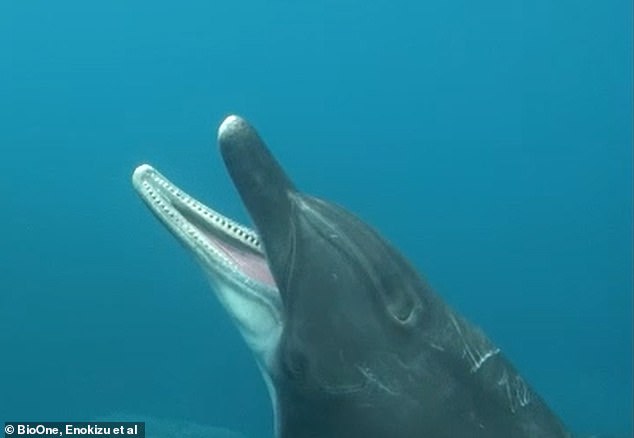Scientists capture first-ever footage of dolphins YAWNING in the wild – and say discovery changes definition of the reflex
Scientists have captured the first-ever footage of a dolphin yawning underwater, showing that the aquatic mammal is closer to humans than previously thought.
Researchers at MIT found that dolphins seemed more active after opening their jaws wide – similar to the way we behave after inhaling and exhaling deep breaths.
Doctors have long known yawning as an unconscious action consisting of three parts: opening the mouth slowly and inhaling, keeping the mouth open, and then closing it quickly while exhaling.
The new research suggests it's time to change that definition, study author Tadamichi Morisaka, a dolphin researcher at Mie University, told DailyMail.com.
Morisaka said the new definition should exclude breathing, and only describe mouth movements: opening slowly, holding widely, and closing quickly.

In the final stage of a dolphin's “yawn,” the animal quickly closes its wide-open mouth. But she's not breathing. Scientists say the fact that dolphins yawn without breathing changes what we know about yawning
We tend to know a yawn when we see one, and after watching nearly 2,000 hours of video to spy the familiar sight, Morisaka and his team concluded that dolphins yawn underwater.
Video recordings showed that they do this most often in the morning when they feel sleepy.
As in humans, the action seemed refreshing: the dolphins behaved temporarily more active after yawning.
“These reports of breathless yawning suggest that breathing during yawning is not critical for yawning in animals, including humans,” Morisaka said.
In 2021, Morisaka and his colleagues discovered Same behavior In captive dolphins: The animals open their mouths in a manner similar to a yawn.
“At first, this struck us as strange rather than surprising,” Morisaka said.
“However, at the time, we could not conclusively conclude that it was an actual yawn, as dolphins exhibit yawning behavior underwater without breathing.”


The dolphin opens its mouth wide before closing it. The animal was not feeding, and did not appear to be playing or communicating with any other dolphins. Scientists concluded that he was yawning
They also observed yawn-like mouth movements in captive dugongs, another aquatic mammal.
So they thought this behavior might be unique to animals living in captivity, the kind of abnormal and repetitive behavior that some animals can develop in zoos or aquariums, where they can't move as freely as they do in nature.
Morisaka and his team set out to conduct a comprehensive investigation into what was happening with the so-called yawning dolphins.
They watched 1,816 hours of video of dolphins taken from 2012 to 2017 off the coast of Mikura Island, about 120 miles south of Tokyo.
In these videos, they recorded 94 times when the dolphins opened their mouths.
In 89 videos, there was a clear purpose for the dolphin opening its mouth.
According to the study, “threatening behavior towards another individual, feeding behavior when biting fish, or social behavior such as playing with another individual.”
But the remaining five had no clear reason for the animal to open its mouth.
Suspected yawning cases followed a similar pattern, with Morisaka's team writing: “Stage 1, slowly opening mouth; Stage 2, maintaining maximum mouth opening; Stage 3, rapid closing.”
All five yawns occurred mid-morning when most of the dolphins in the group would normally be resting.
The team published its results in the journal Biwan.
“Our latest paper has finally shown that dolphins actually yawn,” Morisaka told DailyMail.com.
Although the new research does not explain why dolphins yawn, the first research did suggest a purpose for the behavior.
In some cases, captive dolphins have temporarily become more active after yawning.
As a result of their work, Morisaka and his colleagues proposed changing the definition of yawning to remove breathing from the equation: “Yawning is an involuntary action, occurring in three stages: slow mouth opening, maintaining maximum mouth volume, and rapid closing.” .'
To follow up on this work, Morisaka said, they plan to study yawning behaviors in other marine organisms, including sea turtles and fish with lungs.
(Tags for translation) Daily Mail
